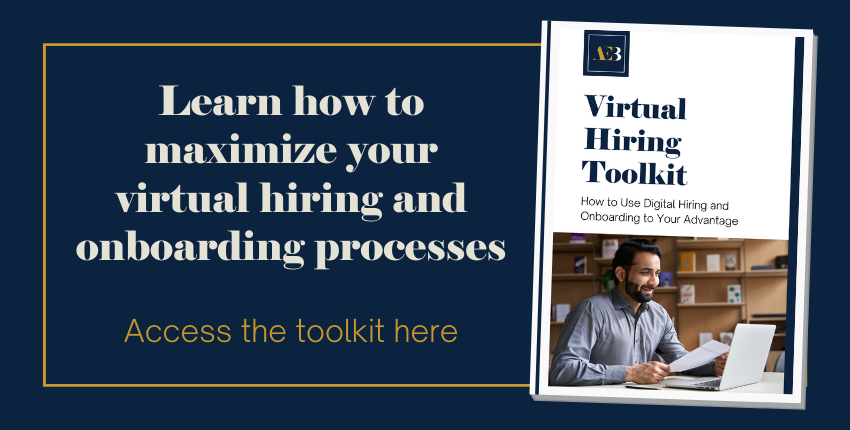No longer are companies trying to figure out how to shift their employees into a productive remote workforce. The forced transition happened quickly. Since the rapid change, both employers and employees have been assessing the results and preferred format.
Now organizations are focused on striking a balance between remote, in-office, and a hybrid style and find a whole new set of questions and challenges to resolve. The number of candidates asking about remote work options and policies has dramatically increased, and will likely continue to be a key attribute to attracting new talent, as well as retaining current employees.
This means organizations should be asking themselves the following questions: Does working remotely change how managers lead their teams and individual members? Do employers need to rethink how they engage with their employees?
Learn why having an engaged workforce is beneficial, how to both effectively engage and manage your remote workforce, and some practical ways to do both.
Benefits of an Engaged Workforce
It is important to understand that employee engagement is not a measurement of job satisfaction; and while a contributing factor, isn’t an assessment of employee feelings toward their role, management, or company. Rather, employee engagement is the level of motivation, involvement, and commitment employees have toward an organization and their willingness to put discretionary effort into their work.
Employees who are inspired by their occupational roles not only have better morale but are also more productive. In turn, the organizations that employ these impassioned individuals have lower turnover rates and better corporate culture than their counterparts. Gallup surveys reveal that organizations with engaged employees see a 17% increase in productivity, 24% less turnover, and 41% less absenteeism. Forbes magazine stated it best when they said, “engaged employees show up every day with passion, purpose, presence, and energy.”
Fostering an engaging workplace and effectively leading your remote workforce is not only good for corporate culture but your bottom line as well.
Ways to Engage with Your Remote Workforce
Expectations of employees working remotely should be identical to those working in person. However, creating and promoting an engaging workplace will look very different when everyone is no longer in the same facility. Engaging a remote workforce requires more intent and deliberate attention from organizational leadership. Here’s how.
Listen to what your workforce is saying…and not saying
The last thing anyone wants is to be the proverbial out of sight, out of mind. Managers at all levels need to proactively listen and seek feedback from their remote workforce. This is true whether working under extreme pressure and chaos or when business is peacefully sailing along. Listen to what your employees are telling you and seek clarification and input when voiced sentiment and requests aren’t so frequent.
Proactively communicate
Keep your teams informed and centralize information needed to perform their roles. In GitLab’s 2021 Remote Work Report, less than half of the 3,900 respondents felt their organization was doing enough to share organizational goals, document processes, set communication standards, or promote visibility across projects. Don’t bombard your remote employees with needless, empty communication. However, make sure vital information and guidance are openly shared promptly.
Create opportunities to connect on a personal level
One point continually raised in various surveys and studies on the growing remote workforce is the need to connect on a personal level. Video conferencing allows remote colleagues to visually see each other, but frequently the topic of conversation is understandably business-related. Regardless of personality styles, people still need and crave human connection. Offer opportunities for your remote workforce to connect outside of work. Doing so encourages personal connections that foster meaningful relationships.
Accept different styles of working
Not everyone works the same way. Some people need a bit of background noise to be productive, while others prefer absolute quiet. In a remote workplace setting, there will be even more variations in how your employees work. While productivity standards and defined hours of availability should be in place, you may need to accept more variety and be more flexible in preferred work styles, such as the specific hours worked or where employees are physically working.
Much of your ability to be accepting of work preferences is dependent on your industry and corporate culture. Consider that some employees may be more productive early in the morning or later at night. Working remotely may mean accommodating family schedules to get kids to and from school. Where your business allows, and depending on the level of collaboration the rest of your team needs, consider where flexibility for when and where employees work can be added.
Create and enforce boundaries
One of the downsides of working remotely was that employees became suddenly available at all times, and many also seemed to work nearly as much. The boundaries between work and home quickly became blurred.
For your remote workforce to remain engaged, focused, and productive, you may need to help them create and enforce boundaries to maintain a healthy work-life balance. Don’t let your employees needlessly burn out. They will appreciate you helping them maintain healthy boundaries.
Start by developing clear work-from-home policies and expectations that define eligibility, working hours, technology requirements, communication and notification requirements, as well as the duration of the arrangement if working remotely is not going to be a permanent option. However, don’t stop here as your policy will only outline the logistics of this working style. Lead by example. If leadership is working all hours of the day, the impression is that your employees need to do the same. Pay attention to the actual hours your remote workforce is engaged with work related activities. Reinforce the need to step away from work to recharge and refocus.
Offer options
Poet William Cowper first coined the phrase, “variety’s the very spice of life that gives it all its flavor.” Most people crave variety whether in their pizza toppings or how they work. Offer your employees options too. If a fully remote workforce isn’t an option for you, consider a hybrid approach with flexibility for what days your team needs to be in the office. Video fatigue is a growing problem, evaluate if every meeting needs to be on video or if a phone call or email will be just as effective. Empower employees to make smart decisions based on their unique situations and preferences.
Continue to recognize exceptional work and employee accomplishments
Recognizing work performance that goes above and beyond should always be acknowledged and noted in a way that is most meaningful to the employee. Continue to be intentional about this for your remote workforce as equally as you would for your in-person employees.
Develop an effective onboarding process
One of the benefits of having a remote workforce is that your talent pool now extends far beyond your immediate geographic area. The challenge though is that onboarding someone working remotely requires a bit more thought and planning. Organizations that do this well, create a seamless transition from candidate to a productive team member.
Get more information on Employee Engagement Strategies by accessing our guide.How to Manage Your Remote Workforce
The fundamentals of leading a team of employees are essentially the same regardless of where your team members perform their work. Yet, what is different is the context from which these fundamentals are framed. Take a look.
Lead by example
Your employees are still watching you. Are you still articulating your company values in your work style, communications, and personal interactions with your staff? If you are working remotely too, pay attention to how you are working. Do you maintain work hours that are realistic and similar to what they would be if you were in office?
GitLab’s 2021 Remote Work Report also revealed that burnout was a serious problem for many. Forty-two percent of survey respondents admitted they struggled to maintain work-life boundaries when working remotely. Show your employees what this looks like and lead by example.
Set clear expectations
Just because the physical location of where your team works may have changed, doesn’t mean how they are expected to work has. Clearly define and share what the rules are, especially if there are any differences to in-office practices. (Incidentally, those differences should be few and far between.)
What hours should your remote employees be available? Is working from places other than a home office or dedicated space acceptable? What if that change in venue was a remote working vacation spot? Being flexible will create better engagement with your employees, but not establishing where the boundaries lie will only frustrate them more in the end.
Make sure your team has the tools they need
This will be more important to consider with new remote team members since you should have this already in place for current employees. Don’t assume that new hires will have the appropriate technology tools needed to effectively perform in their role. While a laptop and cell phone are the essentials, confirm that new employees have an appropriate internet connection speed to support consistent and adequate work productivity and communication with other team members.
Support continuous learning & development
Just because some employees prefer a remote working environment doesn’t mean they don’t have career goals and aspirations. As a manager, you should proactively seek out the career goals of your staff, and then work to support that. Encourage continuous learning and share opportunities for professional development that fit within their ambitions.
Support mental wellness
Bringing awareness of mental wellness to the forefront was one positive aspect of the events of 2020. However, the pervasiveness of mental health challenges that have been uncovered should be a wake-up call for everyone. Employee burnout is on the rise and what overwhelms individuals now isn’t necessarily the same as what overwhelmed us just months ago.
If your organization offers mental wellness support, make sure your employees — remote or not — are aware of these services and how to access them. Continue to be intentional about connecting with your remote workforce. Be proactive about asking how they are doing personally and listen to what they are (or aren’t) saying.
Know your employees
Getting to know someone remotely takes time and deliberate focus on the relationship. How do your employees prefer to be managed? What are their personality styles? What are their personal and professional goals? Do you share the same interest in hobbies, music, sports? Do they like working remotely or do they prefer to be in the office? Be intentional about getting to know your employees as individuals who have so much to offer your organization, as well as yourself.
Practical Ways to Support Employees Working Remotely
Reviewing a detailed list of ideas is informative, but we also know that sometimes having actual examples provides a bit more context. The following examples are some ways that AEBetancourt has worked to effectively lead and engage our employees while maintaining a combination of all three work formats.
Effectively engaging employees
-
Sending pulse surveys at regular intervals in the year, in addition to outside opportunities to understand work habits, preferred styles, and occupational needs. The results were also quickly analyzed and the collective feedback was shared.
-
Intentionally redefining what it means to gather around the water cooler. During the past year, twice a week we would spend 30 minutes or less at the beginning of our workday to just talk about what was happening in our personal lives.
-
Taking advantage of opportunities to connect outside of work. Virtual happy hours were a fun new tradition that will continue as in-person gatherings, as have book clubs and spontaneous outings.
-
Randomly sharing personal events in our lives that happen outside of work that keep us connected and engaged. (We have shared the birth of children, puppy adoptions, mouth-watering recipes, vehicle purchases, and vacation adventures to mention just a few.)
-
Being intentional. Since nearly the beginning of our company, first milestone wins have been celebrated as an entire group over steak dinners. While some modifications have been made, the tradition remains and something we all look forward to.
Leading with intent
-
Leadership leads by example by taking time to focus on family, take vacations, and maintain a balance between professional and personal. Employees are encouraged and supported in doing the same.
-
Starting during the onboarding phase, employees set personal and professional goals they want to achieve over the next one, three, and five years. Progress toward these goals is not just regularly asked about, but proactively supported where possible.
-
AEB offers access to a handful of free counseling sessions to our employees to confidentially use as needed. Mental health is just as important as our physical well-being and our goal is to make sure our employees are performing at their best in all areas of their lives.
-
While “open doors” may take on a different meaning now, employees at all levels of tenure and responsibility remain available to each other for support, guidance, and mentoring.
How we work continues to change. Where we work is no longer defined by a physical address. Yet what remains is that your remote workforce craves engagement with leadership and colleagues as much as in-person employees. Further, working remotely doesn’t mean working alone, but adapting to different styles of effectively leading talented individuals.
For more tips and insider information on hiring and onboarding a remote workforce, access our Virtual Hiring Toolkit here.


.png)






